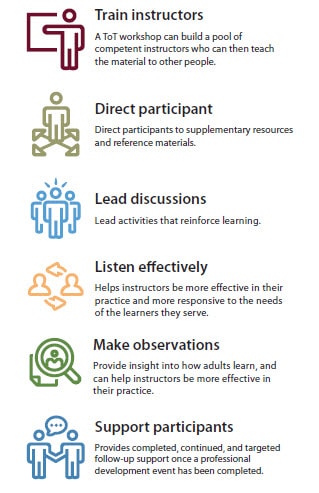At a glance
- The Training of Trainers (ToT) model is intended to engage master trainers in coaching new or less experienced trainers.
- A ToT workshop can build a pool of competent instructors who can then teach the material to others.
How it works
- In the Training of Trainers (ToT) model, instead of having one long-term trainer, there are multiple trainers teaching the same course. This creates: a broader reach; sustainability; and is much more cost and time efficient.
- With the ToT model, a new trainer watches an experienced trainer teach, completes the exercises, and practices teaching segments to others.
- The master trainer and trainer participants should use the CDC Professional Development (PD) best practices.
Goals
The main goal of the Training of Trainers (ToT) model is to prepare instructors to:
- Present information effectively.
- Respond to participant questions.
- Lead activities that reinforce learning.
Other goals include ensuring that trainers can:
- Lead discussions.
- Listen effectively.
- Make accurate observations.
- Help participants link the training to their jobs.
- Direct participants to supplementary resources and reference materials.
Trainer participants also learn the importance of maintaining eye contact, presenting a positive attitude, speaking clearly, and gesturing appropriately. In addition, they learn to maintain interest and dissipate confusion.

Objectives
As a result of attending a ToT, participants will be able to:
- Apply current practices to deliver a training on a selected evidence-based program.
- Use facilitative skills to promote learner engagement, reflective practice, critical thinking, and skill acquisition.
- Show mastery in delivering key training strategies. These may include brainstorming, processing/process checks, role-playing, and practice sessions.
- Use appropriate interventions when managing difficult training situations, including disruptive behaviors.
- Create a personal plan of action to strengthen their training and facilitation skills.
Components
When designing a ToT, allow enough time to ensure the effective transfer of learning. Consider the type and number of topics when determining how much time a training session needs, and include the following elements:
- Pre-assessment.
- Pre-work.
- Trainer and participant agenda.
- Facilitation manual.
- Modeling of the skills and topic to be delivered.
- Adult learning principles.
- Skill practice and feedback.
- Action planning.
- Planned follow-up support.
Definitions
- Pre-assessment—identifies pre-training knowledge, skills, and interest of the trainer participants to determine or inform the training design.
- Pre-work—provides trainer participants with the knowledge and background needed before the actual ToT session.
- Adult learning principles—provide insight into how adults learn. These principles can help instructors be more effective and more responsive to the needs of learners.
- Skill practice and feedback—provide opportunities for practicing training activities/content by asking participants to present to other participants. Participants then provide feedback.
- Action planning—takes participants through the process of creating a plan. The plan outlines the steps to take or activities to perform to make a training successful.
- Planned follow-up support—provides completed, continued, and targeted follow-up support after the PD event. This strengthens participants' knowledge and skills so that they can be transferred, retained, and applied effectively.
Eligibility for participation in a ToT
To effectively achieve intended outcomes, prospective ToT participants must be highly qualified, seasoned trainers who have demonstrated the following:
- An advanced skill level in training and facilitation skills and engagement of adult learners.
- Success in the field and champions for the topic area.
- Completion of the entire training workshop.
- Ability to deliver the training when needed (flexible, able to travel).
